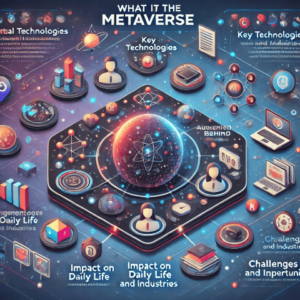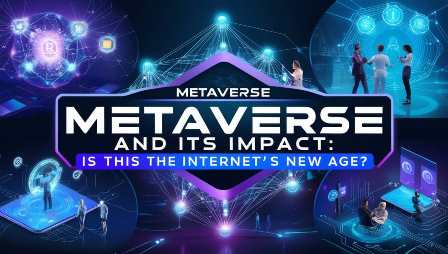Metaverse and Its Impact: Is This the Internet’s New Age?
Metaverse and Its Impact redefine the digital landscape by integrating virtual reality, augmented reality, and blockchain into immersive 3D experiences.
The metaverse is a phrase that has recently gained popularity in the rapidly changing world of technology. But what precisely is the metaverse, and how does it promise to revolutionize our digital existence?
Let’s examine this concept, explore its potential implications for the internet and our lives, and understand why many perceive it as the dawn of the internet age.
What is the Metaverse and how does it work?
The metaverse is a shared virtual realm that blends aspects of augmented reality (AR), virtual reality (VR), blockchain, and digital media. Consider it a walkable internet—a virtual cosmos in which people can connect with one another, create, and even do commerce in 3D.
At its core, the metaverse relies on technologies such as
We use virtual reality (VR) to create immersive experiences.Augmented Reality (AR) combines virtual components with the actual environment.Blockchain and NFTs provide safe ownership of digital assets.We use artificial intelligence (AI) to create lifelike avatars and interactive settings.
How does the Metaverse work?
The metaverse works by combining various technologies to provide seamless virtual interactions.
For example:
- VR headsets provide an immersive environment.
- AR glasses display digital information in real-world settings.
- Blockchain technology secures transactions, allowing users to purchase, sell, and trade virtual products.
- The internet has evolved from web 2.0 to the metaverse.
The internet has progressed significantly since its debut. Web 1.0 primarily focused on static content. Web 2.0 brought interactivity and social media into the picture. Now, the metaverse marks the next step—Web 3.0, in which the internet becomes a completely immersive experience.

Here is a structured tabular representation of the key data :
| Section | Key Points | Examples/Details |
|---|---|---|
| Definition of Metaverse | A shared virtual realm combining AR, VR, blockchain, and AI. | Walkable internet, immersive experiences, lifelike avatars. |
| Core Technologies | – Virtual Reality (VR) for immersion – Augmented Reality (AR) for overlays – Blockchain for secure transactions – AI for dynamic environments. |
VR headsets, AR glasses, NFTs for digital ownership, AI-powered avatars. |
| Evolution of the Internet | Transition from Web 1.0 (static) → Web 2.0 (interactive) → Web 3.0 (metaverse, immersive). | Key differences: 3D interaction, decentralized ownership, virtual presence. |
| Applications in Daily Life | – Entertainment – Social Interactions – Healthcare. |
Virtual concerts, immersive social meetings, 3D therapy sessions. |
| Impact on Businesses | – Virtual workspaces – E-commerce evolution – Recruitment and customer interaction. |
Virtual offices, try-before-you-buy stores, virtual job fairs, interactive brand campaigns. |
| Technological Trends | AI, 5G, blockchain, edge computing for seamless experiences. | High-speed connectivity, secure asset ownership, efficient data processing. |
| Advantages of the Metaverse | – Enhanced connectivity – New opportunities – Inclusive experiences. |
Remote virtual jobs, inclusive virtual activities for people with disabilities. |
| Challenges | – Privacy concerns – Accessibility issues – Digital addiction. |
Sensitive user data, expensive VR equipment, over-reliance on virtual worlds. |
| Economic Impact | Significant contribution to industries like gaming, fashion, real estate. | Roblox economy, virtual property sales, Gucci’s virtual memorabilia. |
| Security Concerns | Data protection, identity theft, cyber harassment in virtual spaces. | Safeguarding virtual identities, developing anti-harassment laws. |
| AI’s Role in the Metaverse | Enhancing interactivity, creating lifelike avatars and environments, efficient data analysis. | AI-powered virtual assistants, adaptive virtual worlds. |
| Future Predictions | – Virtual workspaces replacing video calls – Virtual classrooms – Evolved shopping experiences. |
Immersive remote work, accessible education, and realistic shopping simulations. |
This table summarizes the detailed insights into the metaverse’s impact on life, technology, and industries, making the data easy to grasp at a glance.
Key Differences between Web 2.0 and the Metaverse:
Interaction: Unlike Web 2.0, the metaverse provides a 3D, immersive experience.
Ownership: The metaverse stresses decentralized ownership via blockchain technology.
Users experience a sense of “being there” in the metaverse, as opposed to ordinary web browsing.
The Metaverse and the Future of the Internet
Experts believe the metaverse will change the way we interact with the digital environment. Instead of simply browsing websites, people will use virtual environments for work, leisure, shopping, and other purposes.
Key predictions for the metaverse:
- Workspaces in the Metaverse: Video conversations could be replaced by virtual offices as a more interactive mode of remote work.
- E-commerce Evolution: Brands may develop virtual stores where customers can “try” things before purchasing.
- Education & Learning: Virtual classrooms in the metaverse have the potential to improve learning engagement and accessibility.
How Does the Metaverse Affect Daily Life and Business?
The metaverse has the potential to touch practically every facet of our lives, from entertainment to healthcare. For businesses, it brings up new opportunities for marketing, cooperation, and innovation.
Impact on daily life:
- Entertainment includes virtual concerts, movies, and gaming experiences.
- Social Interactions: A transition from texting and video calling to lifelike virtual meetings.
- Healthcare: Virtual consultations and therapeutic sessions in realistic 3D surroundings.
- Brands can build immersive ad campaigns, similar to Coca-Cola’s sponsored metaverse experiences.
- Recruitment: Virtual job fairs and interviews may become the standard.
- Customer Interaction: Businesses can offer tailored, interactive experiences in virtual environments.
Metaverse Technology Trends: Shaping the Internet
Several technological trends are speeding up the development of the metaverse.
AI is used to create lifelike avatars and flexible environments.5G will enable high-speed, low-latency virtual interactions.
Blockchain and NFTs enable secure transactions and ownership of digital assets.
Edge computing enables seamless data processing closer to the user.The Metaverse has both advantages and disadvantages for users.
Enhanced Connectivity: Communicate with anybody, anywhere, in a lifelike virtual world.
New opportunities include access to virtual jobs, marketplaces, and educational platforms.
Inclusive Experiences: People with impairments can participate in activities that would not be possible in the real world.
Challenges:
Privacy concerns arise when managing sensitive user data in an immersive environment.
Accessibility: The high price of VR equipment may prevent wider adoption.
Digital addiction involves concerns about spending too much time in virtual worlds.
The Economic Impact of the Metaverse in Industries
Experts predict that the metaverse will contribute trillions to the global economy. Industries such as gaming, fashion, and real estate are already taking advantage of its possibilities.
Examples:
Gaming: Roblox and Fortnite are at the forefront of the virtual economy.
Real estate: Virtual properties in the metaverse are selling for millions.
Retail: Companies such as Gucci and Nike have created virtual storefronts and memorabilia.
Security and privacy issues in the Metaverse EraAs the metaverse expands, so do concerns about security and privacy.
Data protection involves safeguarding personal information from potential breaches.Identity Theft: Protecting users’ virtual identities.
Cyber Harassment: Legislation is being developed to prevent harassment in virtual spaces.
How the Metaverse Transforms Online Interactions
Social media services such as Facebook (now Meta) are reinventing online interactions in the metaverse. Rather than reading through feeds, users can explore virtual worlds, attend virtual events, and interact with avatars.




































